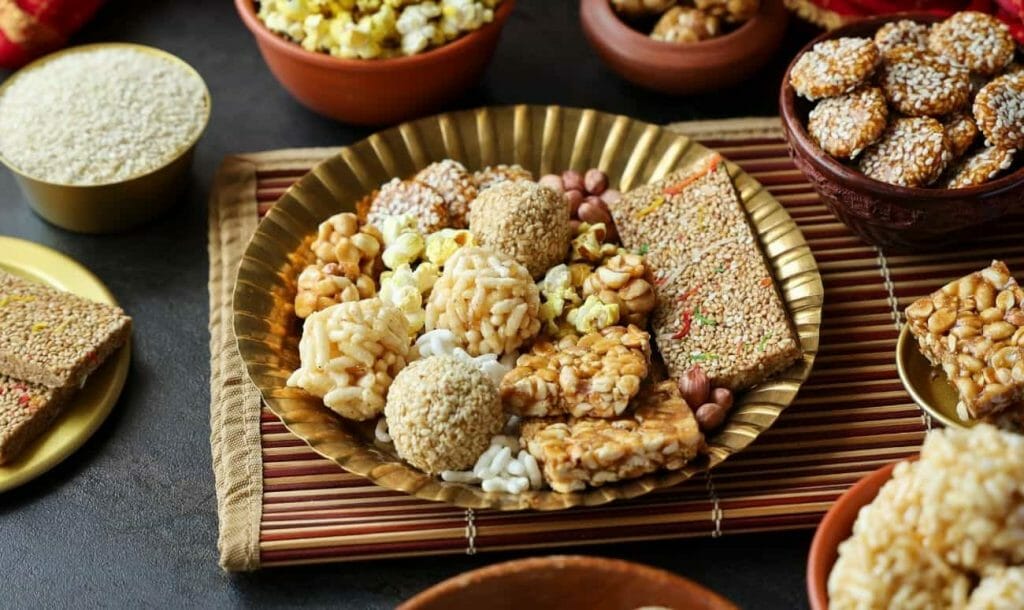The word ‘Uttarayan’, is made of two Sanskrit words ‘uttara’, which means north, and ‘aayana’ which means movement, and it literally translates to the northward movement of the sun. This is why the festival is celebrated on the 14th of January, every year, the day when the sun starts to move northwards, and the days start to get longer. Uttarayan, also known as Makar Sankranti is considered to be a very auspicious day in the Hindu calendar owing to the association of the day with the Sun, which is seen as a symbol of life, knowledge, wisdom and health.
Til (sesame seeds) and gur (jaggery) play a very important role in various rituals that are performed across the country on this day. In Maharashtra, people celebrate Makar Sankranti by feeding each other sweets made from til and gur. The Sindhi community in the country also believes that consuming tir-muri (sesame seeds in the form of sweets and radish in a raw form) is very auspicious. People in certain parts of the country also prepare ‘til laddoos’ and place a coin inside some of them to give an exciting, little game to the kids, and also ensure that they eat the sweets that are very healthy in the wintery cold. In Prayagraj, an annual fair known as the ‘Magh Mela’ begins on the day of Makar Sankranti, and attracts thousands of people who come to the banks of the holy river Ganga to take a dip.
Uttarayan is also celebrated as a festival of harvest in many parts of the country, including Punjab, where it is celebrated over two days in a festival known as ‘Lohri’, and ‘Maghi’. On the eve of Makar Sankranti, huge bonfires light up various streets and corners of Punjab and other parts of northern India. The holy fires serve the purpose of warming up the cold winter night, purifying the air and ending the negativity, and also as a way of expression of gratitude for the winter harvest when the people offer sweets, sugarcane, rice, popcorn to the fires.

The day is also known as ‘Poush Sankranti’ in West Bengal since it falls on the last day of the ‘Poush’ month of the Hindu calendar. On this day, the Bengalis celebrate the festival known as ‘Poush Parbon’, which is to celebrate and express gratitude for the winter harvest. The new crop of rice, and gur (jaggery) made from freshly harvested date palm’s syrup, are used to make various traditional Bengali sweets, and Goddess Lakshmi, the Goddess of wealth is worshipped by offering the sweets to her.
One of the most well-recognized traditions followed on this day is the flying of kites across Gujarat, and even in parts of Rajasthan, Maharashtra and other parts of the country. The skies are filled with a gamut of kites of different sizes and shapes while the families celebrate the kite flying with music and food.
Til laddoo
Ingredients:
½ cup sesame seeds
4-5 cardamom pods
1 tablespoon ghee
½ cup grated jaggery
1 teaspoon milk
Method:
- Roast the sesame seeds in a heavy-bottomed pan over medium heat until fragrant. Set aside to cool.
- Grind the sesame seeds and cardamom seeds together.
- Heat the ghee in a heavy-bottomed pan; add the jaggery and cook, stirring until it melts. Do not let the jaggery boil.
- Add the ground sesame mixture and the milk. Stir briskly to mix well. Remove from heat and leave to cool slightly.
- While still warm, roll small quantities of the mixture into balls. If the mixture is too dry, add a teaspoon of milk to moisten it.
Peanut chikki
Ingredients:
2 teaspoons ghee, plus more for greasing
1 cup peanuts
¾ cup grated jaggery
½ teaspoon ground cardamom (optional)
Method:
- Grease a smooth cutting board or work surface and a rolling pin with ghee.
- Heat a griddle or non-stick pan; add the peanuts and toast them, stirring continuously. Remove from heat. Remove the skin and crush them coarsely.
- Place the jaggery and a tablespoon of water in a heavy-bottomed or non-stick pan. Cook, stirring, on medium-low heat until the jaggery melts. Continue cooking until the jaggery reaches hard-ball consistency. To test, put a drop of melted jaggery in cold water – it should form a hard ball when rolled between your fingers.
- Stir in the ghee and cardamom and remove from heat. Add the peanuts and stir vigorously until they are coated with the jaggery.
- Pour the mixture onto the greased surface and roll out into a thin rectangle. Mark into squares immediately with a greased knife. Leave to cool.
- When completely cooled, separate the squares and store them in an airtight container.
Revadi
Ingredients:
¼ cup white sesame seeds
1½ cups sugar
¾ cup water
¾ teaspoon salt
¾ cup corn syrup
1 tablespoon rose water
1 teaspoon cardamom powder
1 tablespoon ghee
Method:
- Dry roast white sesame seeds in a heavy-bottomed pan for 2-3 minutes on medium-low flame. Keep aside.
- Combine sugar, water, salt and corn syrup in a deep heavy-bottomed pan and place it on medium flame. Add rose water and cardamom powder. Keep stirring only till the sugar dissolves. Cook until the syrup turns bubbly.
- Pour it on a silicone mat and spread evenly. Allow it to cool for one minute. Using a spoon, gather syrup towards the centre of the mat. Keep mixing until it slightly cools down to thicker consistency.
- Grease your palms with clarified butter and start kneading. Pull and fold. Repeat until the mixture turns creamy-white.
- Keep 2 tablespoons of sesame seeds aside; spread rest on the mat. Incorporate them into the dough by pulling and folding.
- Divide the dough into six portions. Using your palms, roll out cylinders of ½ inch thickness. Cut ¼-inch disks out of each cylinder. Shape them into balls and flatten them by gently pressing them between your palms.
- Coat the disks with the remaining sesame seeds and store them in an airtight container.
Dr. Deepali Kampani is a digital content specialist who weaves health and food through her pen.
Read more: A Winter Favourite From The Yellow Fields Of Punjab: Makki Di Roti Te Sarson Da Saag
Like & Follow ThinkRight.me on Facebook, Instagram, Twitter, and Telegram to stay connected.






























